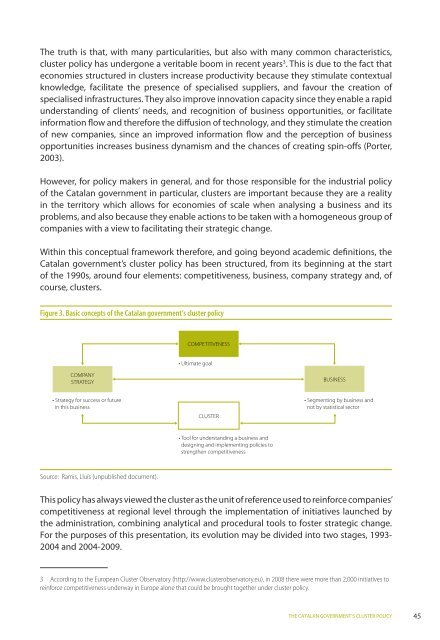Clusters and competitiveness - PRO INNO Europe
Clusters and competitiveness - PRO INNO Europe
Clusters and competitiveness - PRO INNO Europe
Create successful ePaper yourself
Turn your PDF publications into a flip-book with our unique Google optimized e-Paper software.
The truth is that, with many particularities, but also with many common characteristics,<br />
cluster policy has undergone a veritable boom in recent years 3 . This is due to the fact that<br />
economies structured in clusters increase productivity because they stimulate contextual<br />
knowledge, facilitate the presence of specialised suppliers, <strong>and</strong> favour the creation of<br />
specialised infrastructures. They also improve innovation capacity since they enable a rapid<br />
underst<strong>and</strong>ing of clients’ needs, <strong>and</strong> recognition of business opportunities, or facilitate<br />
information flow <strong>and</strong> therefore the diffusion of technology, <strong>and</strong> they stimulate the creation<br />
of new companies, since an improved information flow <strong>and</strong> the perception of business<br />
opportunities increases business dynamism <strong>and</strong> the chances of creating spin-offs (Porter,<br />
2003).<br />
However, for policy makers in general, <strong>and</strong> for those responsible for the industrial policy<br />
of the Catalan government in particular, clusters are important because they are a reality<br />
in the territory which allows for economies of scale when analysing a business <strong>and</strong> its<br />
problems, <strong>and</strong> also because they enable actions to be taken with a homogeneous group of<br />
companies with a view to facilitating their strategic change.<br />
Within this conceptual framework therefore, <strong>and</strong> going beyond academic definitions, the<br />
Catalan government’s cluster policy has been structured, from its beginning at the start<br />
of the 1990s, around four elements: <strong>competitiveness</strong>, business, company strategy <strong>and</strong>, of<br />
course, clusters.<br />
Figure 3. Basic concepts of the Catalan government’s cluster policy<br />
COMPANY<br />
STRATEGY<br />
• Strategy for success or future<br />
in this business<br />
Source: Ramis, Lluís (unpublished document).<br />
COMPETITIVENESS<br />
• Ultimate goal<br />
CLUSTER<br />
• Tool for underst<strong>and</strong>ing a business <strong>and</strong><br />
designing <strong>and</strong> implementing policies to<br />
strengthen <strong>competitiveness</strong><br />
BUSINESS<br />
• Segmenting by business <strong>and</strong><br />
not by statistical sector<br />
This policy has always viewed the cluster asthe unitof reference usedto reinforce companies’<br />
<strong>competitiveness</strong> at regional level through the implementation of initiatives launched by<br />
the administration, combining analytical <strong>and</strong> procedural tools to foster strategic change.<br />
For the purposes of this presentation, its evolution may be divided into two stages, 1993-<br />
2004 <strong>and</strong> 2004-2009.<br />
3 According to the <strong>Europe</strong>an Cluster Observatory (http://www.clusterobservatory.eu), in 2008 there were more than 2,000 initiatives to<br />
reinforce <strong>competitiveness</strong> underway in <strong>Europe</strong> alone that could be brought together under cluster policy.<br />
THE CATALAN GOVERNMENT’S CLUSTER POLICY<br />
45
















